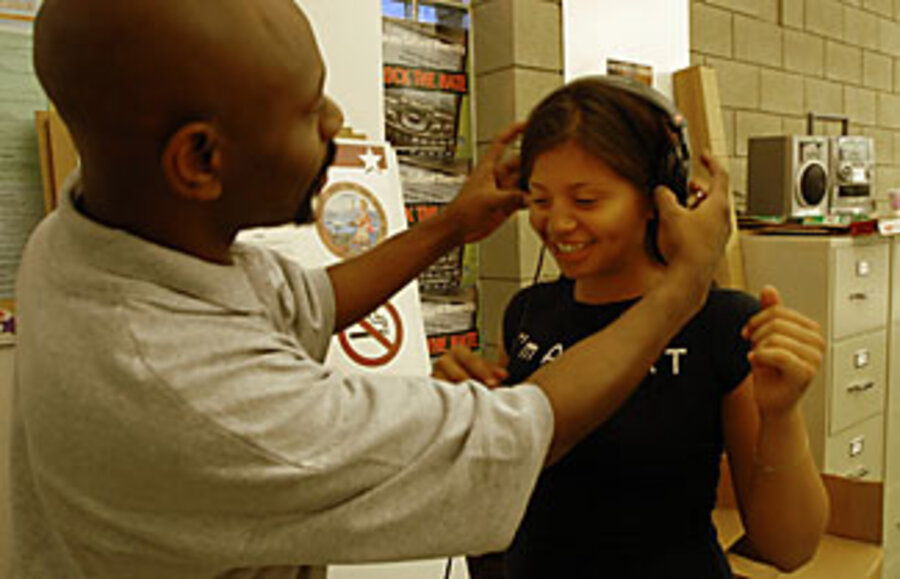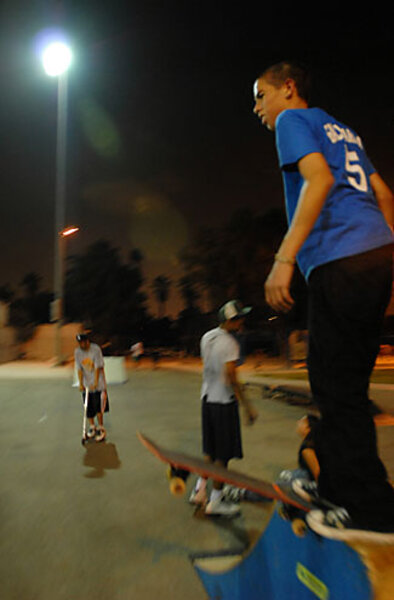To deter crime, Los Angeles leaves the lights on
Loading...
| Los Angeles
The lights burned late on a recent Saturday, casting an inviting glow over Ross Snyder Park in a notoriously rough South Los Angeles neighborhood. The park pulsated with the sound of children as the community staked its claim – at least for a few hours – to the fields and benches that typically turn into the province of gang members when night falls.
Throughout the summer, Los Angeles Mayor Antonio Villaraigosa is keeping eight city parks and adjoining recreation centers open until midnight four nights a week in some of the city's highest-crime districts. There's basketball and soccer, hip-hop and free food. He hopes it's enough to draw some of the city's most at-risk young people away from the sway of the 720 gangs active in the city.
It is too soon to judge the impact of the program dubbed "Summer Night Lights" that began July 4, but early indicators suggest it's having an effect. As of Aug. 2, homicides dropped 5.2 percent citywide compared with the same period last year and Los Angeles recorded 19 homicides last month, compared with 42 in July 2007. That's the lowest monthly total since March 1970.
The city did not provide statistics for the areas around the eight parks it's targeting over the summer, but the mayor's office said "overall crime, gang-related violence, and homicides are down" in those parts of Los Angeles.
Anticrime initiatives such as these are certainly not new. But with a broad approach that involves both intervention and outreach, Summer Night Lights could prove to be a model for battling gang violence. It's forging cease-fires between rival groups to ensure that turf battles don't punctuate the late-night affairs, and it's employing corps of young people in groups called Youth Squads to promote and staff the programs.
"I hope that it becomes a template for what we need to do across the nation to address the scourge of gun and gang violence," says Mr. Villaraigosa. "The fact of the matter is that you have to do it all. You have to have suppression. You have to do prevention and intervention, and you have to make a serious investment in both."
The mayor's office raised nearly $1 million from donors to fund the program that will run through Labor Day in its Gang Reduction and Youth Development (GRYD) zones.
"When we started conceptualizing Summer Night Lights, we wanted to create a space that would be a safe neutral zone for young people," says Tony Zepeda, GRYD program manager for the Newton district, which includes Ross Snyder Park. "If there's a gang member who wants to play basketball, soccer, or box, they are not going to be harassed."
Los Angeles Police Department (LAPD) officers were nowhere to be seen that night. But Mr. Zepeda says they were indeed there and ready to respond if needed. Officers keep a low profile, he says, so they don't frighten off gang members who may want to come out and join in, which is an important component of the initiative. While the program aims to steer potential members away from gangs, organizers also want to show those already initiated a way out.
"We hired young people [to be part of the Youth Squads] who are right on the fence of going the wrong way or the right way. Their family members are associated with gangs and some have already tried it out," says Zepeda, who grew up near Ross Snyder Park. "We hope this motivates them to go the right way."
Many of the young people that night talked about a shooting just the day before. It was across from the park. They say it kept many kids and their parents away that night. The soccer field was still full of dozens of youngsters, and smatterings of teenagers hung around inside and outside the recreation center. But it was a relatively sparse turnout compared with other Summer Night Light evenings in the city.
"There are shootings [in this area] every day. For the first time, here's a park that's open. The LAPD is here. People feel like they are safe. The reality is that if this wasn't here, someone would have gotten shot in the park," says Zepeda.
L.A. has some 39,000 gang members and, according to the Los Angeles Times, while serious crimes dropped overall in 2007, gang-related crimes increased 14 percent. In South Los Angeles, the newspaper reported, gang violence climbed 25 percent.
In the Newton district alone, an estimated 47 gangs, many with overlapping turf, are active within 9.8 square miles, according to an assessment of the area by the Advancement Project, a public policy group. In a report that was commissioned by the mayor's office, it says that Newton is "one of the most gang saturated areas of the City of Los Angeles."
"Community members were asked at what age young people were being recruited to join gangs. The most consistent answer was around 10 years old or fifth grade," according to the report.
Inside the park's recreation center, Brizanery Gomez says she has had more than her fair share of brushes with gang violence. "One of my best friends died in a car accident doing a drive-by. We were only in the eighth grade.... It used to be every day, shootings and killings. I guess I got used to it."
In an ad hoc recording studio set up at the recreation center, the 15-year-old keeps the microphone close to her mouth, tries to hold back an embarrassed smile, and raps over a repetition of slow beats. A poster on the cinderblock wall behind her reads, "No Haters Here." Instructors and others in the poetry and hip hop class look on as she tests her rhyme.
"It's cool because they get you confident and they get you to express your feelings," says Brizanery of the instructors. Later, she darts off to an improv class.
Alex Alonso, who runs the website streetgangs.com, which chronicles gang activity in L.A., says the largest gang in the Newton district is the 38th Street Gang, whose graffiti is sprayed across a long metal trash bin at the park. "In an average gang neighborhood, you have about 15 percent of young people joining up," says Mr. Alonso. Most "of these guys are born into it."
Alonso says Summer Night Lights needs to be expanded. "We need more of these programs. We're talking about a few neighborhoods for only a small duration in time." Still, he says, "Once it's over, we'll be able to look at the data and see that it had a positive impact."
On a Saturday night last summer, Ross Snyder would have been an "empty space ... an attractive public nuisance for guns, gangs, crime, and drugs," says Villaraigosa. "Now, it's a safe haven, a magnet for building community, for bringing people out of the darkness and into the light."






